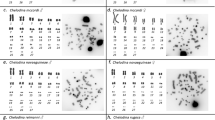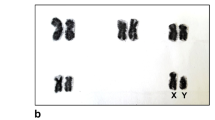Abstract
The complex sex chromosome system of Lagorchestes conspicillatus has been reinvestigated using G-banding, Hoechst 33258 sensitivity, and Ag staining. These investigations demonstrate that, as proposed, three exchanges have been involved in the evolution of this system. An autosome was translocated to the original X and the homologue of that autosome was translocated to the original Y. An additional autosome has been translocated to the Y. There is no sex vesicle at meiosis in the male, and no association between the original X and Y elements of the compound chromosomes. The inadequacies of the present terminology for complex sex chromosomes are considered and an alternative system suggested.
Similar content being viewed by others
References
Benirschke, K., Ruedi, D., Muller, H., Kumamoto, H., Wagner, K.L., Downes, H.S.: The unusual karyotype of the lesser kudu. Cytogenet. Cell Genet. 26, 85–92 (1980)
Bloom, S.E., Goodpasture, C.: An improved technique for the selective silver staining of nucleolar organiser regions in human chromosomes. Hum. Genet. 34, 199–206 (1976)
Charlesworth, D., Charlesworth, B.: Sex differences in fitness and selection for centric fusions between sex chromosomes and autosomes. Genet. Res. (Camb.) 35, 205–214 (1980)
Chicago Conference: Standardisation in Human Cytogenetics. Birth Defects: Original Article Series Vol. 2 (1966)
Dresser, M.E., Moses, M.J.: Synaptonemal complex karyotyping in spermatocytes of the Chinese hamster (Cricetulus griseus). IV. Light and electron microscopy of synapsis and nucleolar development by silver staining. Chromosoma (Berl.) 76, 1–22 (1980)
Elder, F.F.B., Pathak, S.: Light microscopic observations on the behavior of silver-stained trivalents in pachytene cells of Sigmodon fulviventer (Rodentia, Muridae) heterozygous for centric fusion. Cytogenet. Cell Genet. 27, 31–38 (1980)
Evans, E.P., Breckon, G., Ford, C.E.: An air drying method for meiotic preparations from mammalian testes. Cytogenetics 3, 289–294 (1964)
Fletcher, J.M.: Light microscope analysis of meiotic prophase chromosomes by silver staining. Chromosoma (Berl.) 72, 241–248 (1979)
Fredga, K.: Unusual sex chromosome inheritance in mammals. Phil. Trans, roy. Soc. Lond. B 259, 15–36 (1970)
Hayman, D.L., Martin, P.G.: Mammalia 1: Monotremata and Marsupialia. Vol. 4: Chordata 4. In: Animal cytogenetics (B. John, ed.), 1–110. Berlin, Stuttgart: Gebrüder Borntraeger 1974
Hayman, D.L., Martin, P.G., Waller, P.F.: Parallel mosaicism of supernumerary chromosomes and sex chromosomes in Echymipera kalabu (Marsupialia). Chromosoma (Berl.) 27, 371–380 (1969)
Hayman, D.L., Rofe, R.H.: Marsupial sex chromosomes. In Reproduction and Evolution (J.H. Calaby and C.H. Tyndale-Biscoe, eds.), 69–79. Canberra: Aust. Acad. Sci. 1977
Hayman, D., Sharp, P.: Hoechst 33258 induced uncondensed sites on marsupial chromosomes. Chromosoma (Berl.) 83, 249–262 (1981)
Hilwig, I., Gropp, A.: Decondensation of constitutive heterochromatin in L cell chromosomes by a benzimidazole compound (“33258” Hoechst). Exp. Cell Res. 81, 474–477 (1973)
McIntosh, J.R., Sharman, G.B.: The chromosomes of some species of marsupials. J. Morph. 93, 309–331 (1953)
Martin, P.G., Hayman, D.L.: A complex sex chromosome system in the hare-wallaby Lagorchestes conspicillatus Gould. Chromosoma (Berl.) 19, 159–175 (1966)
Matsui, S., Sasaki, M.: Differential staining of nucleolus organisers in mammalian chromosomes. Nature (Lond.) 246, 149–150 (1973)
Pathak, S., Hsu, T.D.: Silver-stained structures in mammalian meiotic prophase. Chromosoma (Berl.) 70, 195–203 (1979)
Pathak, S., Stock, A.D.: Giemsa banding and the identification of the Y-autosome translocation in the African marsh monogoose Atilax poludinosus (Carnivora: Viverridae). Cytogenet. Cell Genet. 16, 487–494 (1976)
Seabright, M.: A rapid banding technique for human chromosomes. Lancet 1971II, 971–972
Sharman, G.B.: The mitotic chromosomes of marsupials and their bearing on taxonomy and phytogeny. Aust. J. Zool. 9, 38–60 (1961)
Sumner, A.T.: A simple technique for demonstrating centromeric heterochromatin. Exp. Cell Res. 75, 304–306 (1972)
Wallace, C.: Chromosome analysis in the Kruger National Park: the chromosomes of the bush buck (Tragelaphus scriptus). Cytogenet. Cell Genet. 18, 50–56 (1977)
White, M.J.D.: Animal cytology and evolution, 3rd edit. Cambridge: University Press 1974
Wurster, D.H.: Sex-chromosome translocations and karyotypes in bovid tribes. Cytogenetics 11, 197–207 (1972)
Author information
Authors and Affiliations
Rights and permissions
About this article
Cite this article
Hayman, D., Sharp, P. Verification of the structure of the complex sex chromosome system in Lagorchestes conspicillatus Gould (Marsupialia: Mammalia). Chromosoma 83, 263–274 (1981). https://doi.org/10.1007/BF00286794
Received:
Issue Date:
DOI: https://doi.org/10.1007/BF00286794




